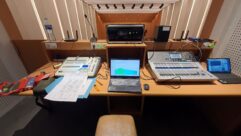
Williams Sound PPA T35/PPA R35E
Nov 1, 2006 12:00 PM,
By John McJunkin
User-friendly system makes for easy listening.
Typically in public access situations such as theaters, music performances, or other similar scenarios, a professional audio engineer may be employed to oversee the quality (and quantity) of the sound. Unfortunately, it’s too much to expect that engineer to also personally oversee the administration of an assistive-listening system. The primary systems engineer is simply not going to be charged with the task of handing out receivers to patrons and explaining their operation.

The obvious implication is that non-professionals must be able to handle the operation of the system and to administer the use of the receivers. If a system is too complex, this can be difficult, if not impossible. I recently spent time with a Williams Sound PPA T35 transmitter and four PPA R35E receivers and discovered they make operation and administration simple enough for a non-professional to easily understand.
The center of the system is the half-rack-unit PPA T35 transmitter. The front-panel controls, starting from the left, consist of a power switch, an “on-air” transmission-indicating LED, and a 10-segment LED input VU meter with a separate LED to indicate input overload. Next areup/down buttons to adjust the audio level, followed by a four-line by 21-character LCD alphanumeric display, which is the system’s primary means for communicating operational information.
To the right of the display are four navigation buttons — up, down, left (-), and right (+). A “set” button below the navigation buttons executes any command that has been chosen using the buttons. Finally, on the far right of the panel are a 1/4in. headphone jack and the unit’s “direct-access” buttons — specifically, volume up and down and a source select button. The point of these controls is to enable quick access to these often-used controls without any menu diving. I always appreciate this notion, particularly with emergency cut-off or shutdown type controls. I found this front panel to be straightforward, and frankly, I did not have to open the manual at all to understand it.
Likewise, the transmitter’s rear panel simply could not be any more fundamental or straightforward — exactly the way I like things. From left to right, you’ll first find the unit’s audio input, which is one of those clever Neutrik inputs that accepts either XRL or 1/4in. balanced or unbalanced connectors. To the immediate right of that input is a handy RCA audio line output, which passes audio from the unit, post-processing, for recording or hand-off to another system.
There is a 75Ω antenna connection located right in the middle of the rear panel, and also a connector on the top of the unit for a whip antenna. The point of the adjunct connector on the rear panel is to ensure the whip antenna cannot be used if the transmitter is rackmounted. A rackmounting kit is indeed available, although it is important to note that you cannot legally use both antennas at the same time.
Finally, on the far right of the rear panel is the unit’s power input, which accepts 24VDC from the included proprietary wall-wart.
The PPA R35E receivers are also very simple, and a pleasure to use. Atop each belt-pack (which has a belt-clip but could also be dropped into a pocket or a purse) is an 1/8in. TRS output, an on/off volume wheel, and a LED On indicator. The battery compartment opens to accept alkaline or NiMH batteries, which can be recharged by placing the receiver in an optional eight-unit recharging base. Within the battery compartment is also an adjustment point for frequency.
Operation of the system is, as I said before, exceedingly simple. I literally connected the output of my mixer to the input of the transmitter, turned the transmitter on, and turned on the receiver that I had attached to my belt. Through the included earpiece, I began to hear my mixer’s output as I brought the level up — very simple. Williams Sound recommends that, generally, users should simply feed the signal, unprocessed, into the transmitter, and use the transmitter’s onboard processing to accomplish any necessary compression and/or filtering, but they also suggest using time compensation delay in larger venues. This may require all listening-assisted patrons to sit in the same part of the venue so that the delay can be set for that particular location.
The transmitter does provide filtering and compression — specifically a high-pass filter that ranges from 22Hz to 700Hz, a low-pass filter that ranges from 3.2kHz to 16kHz, and a compressor with ratios (“slope” in the Williams Sound vernacular) ranging from 1:1 to 6:1.
I appreciate the inclusion of the high-pass filter due to its ability to eliminate the low frequencies that the miniature earpiece could never reproduce anyway. The low-pass filter is also handy because it eliminates the transmission of precisely the frequency range that is most likely to be attenuated in the hearing of a person who suffers from hearing impairment. Via filtering, the compression (and RF transmission energy) can be focused upon the important range of intelligibility frequencies. On the other hand, full bandwidth can be broadcast for those who simply need a little assistance. I appreciate this flexibility, which enables the engineer to adjust the system to meet the specific needs of the audience. I also like the system’s three application presets — hearing assist, music, and voice. Each configures the filters and compression to best present the signal to the audience for that particular application. The filtering and compression parameters of each preset can be further tweaked to optimize the quality.
One item I’d put on my wish list would be the ability to adjust filtering and compression on the receiver end. As it stands now, the same processed signal is sent to all receivers, regardless of the specific needs of each listener. Obviously, this suggestion would be an upgrade that would substantially increase the price of the system’s receivers, and the low price is one of the strong appeals of this system.
Overall, I would call the Williams Sound PPA T35/PPA R35E combination a solid, high-quality solution at an appealing price. Moreover, it solves the dilemma to which I initially called attention — the necessity for non-engineers to be able to administer the user part of the application. It’s simple from that standpoint, it sounds good, and it effectively accomplishes the goal of providing hearing assistance downright inexpensively. I would strongly recommend it for any organization that requires a hearing-assistance system.
PRODUCT SUMMARY
Company: Williams Sound www.williamssound.com
Pros: Straightforward setup exceedingly simple to use, solid quality.
Cons: Intelligibility-boosting EQ would be nice at the receiver.
Price: Transmitter: $685; receiver: $110
SPECIFICATIONS
Operating Frequencies: 10 72.1MHz-to-75.9MHz wideband channels and seven non-standard wideband channels or 77 72.025MHz-to-75.975MHz narrowband channels
Nominal Range: Up to 1,000ft.
Frequency Response: 22Hz to 16kHz
Signal-to-Noise Ratio: 74dB transmitted
Nominal Input Levels (Balanced or Unbalanced): Microphone Simplex mic: -60dBV (1mVrms); line: -8dBV (400mVrms); common mode rejection: >57dB at 1kHz (mic or line); total harmonic distortion: <0.25 percent at -10dBV (audio line)
John McJunkinis the principal of Avalon Audio Services in Chandler, Ariz. He consults in the development of studios and installations and provides a large variety of recording and production services.










